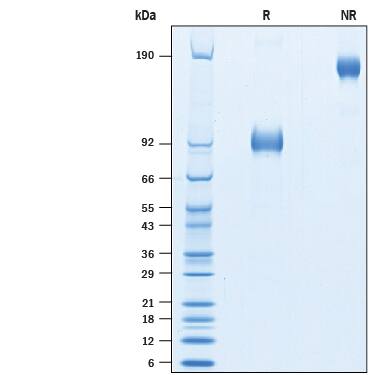Recombinant Human MICA Fc Chimera Avi-tag Protein, CF
R&D Systems, part of Bio-Techne | Catalog # AVI1300

Key Product Details
Source
Accession #
Structure / Form
Conjugate
Applications
Product Specifications
Source
| Human MICA (Ala23-Gln308) Accession # NP_001170990.1 |
IEGRMD | Human IgG1 (Pro100-Lys330) |
Avi-tag |
Purity
Endotoxin Level
N-terminal Sequence Analysis
Predicted Molecular Mass
SDS-PAGE
Activity
When Recombinant Human NKG2D Fc Chimera (Catalog # 1299-NK) is immobilized at 1 μg/mL (100 µL/well), the concentration of Biotinylated Recombinant Human MICA Fc Chimera Avi-tag (Catalog # AVI1300) that produces 50% of the optimal binding response is found to be approximately 7.5-45 ng/mL.
Scientific Data Images for Recombinant Human MICA Fc Chimera Avi-tag Protein, CF
Recombinant Human MICA Fc Chimera Avi-tag Protein Binding Activity
When Recombinant Human NKG2D Fc Chimera (Catalog # 1299-NK) is immobilized at 1 µg/mL (100 µL/well), the concentration of Biotinylated Human MICA Fc Chimera Avi-tag (Catalog # AVI1300) that produces 50% of the optimal binding response is found to be approximately 7.5-45 ng/mL.Recombinant Human MICA Fc Chimera Avi-tag Protein SDS-PAGE
2 μg/lane of Biotinylated Recombinant Human MICA Fc Chimera Avi-tag (Catalog # AVI1300) was resolved with SDS-PAGE under reducing (R) and non-reducing (NR) conditions and visualized by Coomassie® Blue staining, showing bands at 85-100 kDa and 170-200 kDa, respectively.Formulation, Preparation and Storage
AVI1300
| Formulation | Lyophilized from a 0.2 μm filtered solution in PBS with Trehalose. |
| Reconstitution | Reconstitute at 500 μg/mL in PBS. |
| Shipping | The product is shipped at ambient temperature. Upon receipt, store it immediately at the temperature recommended below. |
| Stability & Storage | Use a manual defrost freezer and avoid repeated freeze-thaw cycles.
|
Background: MICA
MICA (MHC class I chain-related gene A) is a transmembrane glycoprotein that functions as a ligand for human NKG2D. A closely related protein, MICB, shares 85% amino acid identity with MICA. These proteins are distantly related to the MHC class I proteins. They possess three extracellular Ig‑like domains, but they have no capacity to bind peptide or interact with beta2-microglobulin. The genes encoding these proteins are found within the Major Histocompatibility Complex on human chromosome 6. The MICA locus is highly polymorphic with more than 50 recognized human alleles. MICA is absent from most cells but is frequently expressed in epithelial tumors and can be induced by bacterial and viral infections. MICA is a ligand for human NKG2D, an activating receptor expressed on NK cells, NKT cells, gamma delta T cells, and CD8+ alpha beta T cells. Recognition of MICA by NKG2D results in the activation of cytolytic activity and/or cytokine production by these effector cells. MICA recognition is involved in tumor surveillance, viral infections, and autoimmune diseases.
References
- Groh, V. et al. (2001) Nature Immunol. 2:255.
- Stephens, H. (2001) Trends Immunol. 22:378.
- Bauer, S. et al. (1999) Science 285:727.
- Groh, V. et al. (2002) Nature 419:734.
- Steinle, A. et al. (2001) Immunogenetics 53:279.
- Pende, D. et al. (2002) Cancer Res. 62:6178.
- NKG2D and its Ligands (2002) http://www.RnDSystems.com
Long Name
Alternate Names
Entrez Gene IDs
Gene Symbol
UniProt
Additional MICA Products
Product Documents for Recombinant Human MICA Fc Chimera Avi-tag Protein, CF
Product Specific Notices for Recombinant Human MICA Fc Chimera Avi-tag Protein, CF
For research use only

